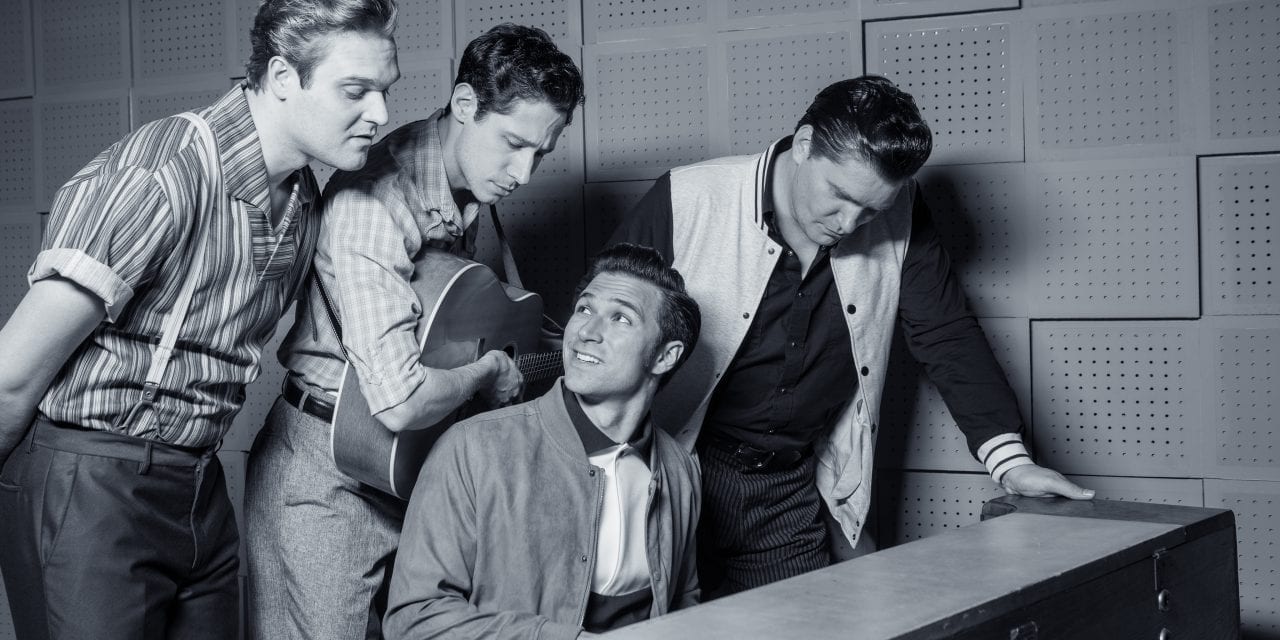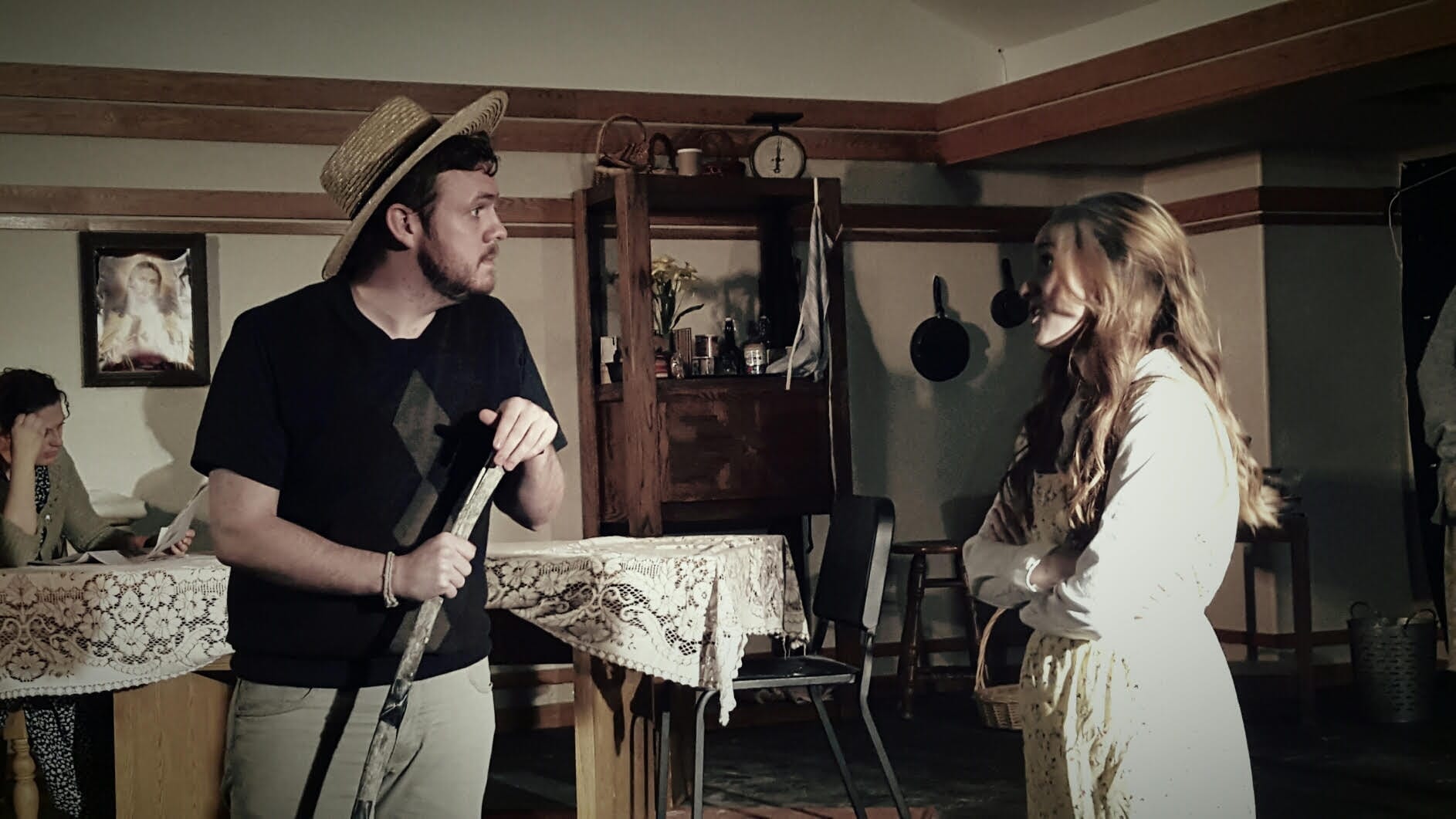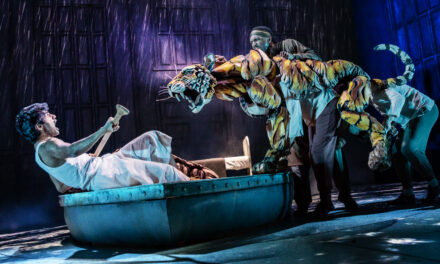OREM — Million Dollar Quartet is a jukebox musical based on the actual impromptu recording session at Sun Studio in 1956. The show is based on a book by Colin Escott and Floyd Mutrux. It features the musical genius of Elvis Presley, Johnny Cash, Carl Perkins, and Jerry Lee Lewis. An electrifying presentation of a truly monumental day in music history, Million Dollar Quartet begs the question, “what does rock and roll mean?”

Show closes August 3, 2019.
Opening with a rousing rendition of, “Blue Suede Shoes,” performed by the company, the show quickly hints to the nostalgic fun and entertainment to come. Then the set clears and each legend has his own introduction exhibited through the boisterous lens of Sun Records founder Sam Phillips (played by Blake Barlow). Designed by Cole McClure, the set is a proper rendering of a 1950’s recording studio with a black and white checkered floor, a collection of musical instruments, and classic retro style mic stands. Million Dollar Quartet often pays tribute to the past with minute details. One tribute is the price of gas being a whopping 25 cents per gallon. Additionally, each musician has a historically accurate personal journey; the death of Johnny Cash’s brother and the fact that Jerry Lee Lewis has a second marriage before the end of his first marriage are included.
The show also imparts an intimate look at the highs and lows of fame, the politics of the record industry, and the volatility of success in music. The artists share similarities in background, each artists stemming from small farm towns in the south as well as a Christian upbringing full of gospel music. Likewise, the group shares a certain degree of straying from their Christian upbringing and the inability to find fame through wholesome gospel music. The camaraderie is exemplified in the number, “Down by the Riverside.” This number is a fantastic harmony including the entire company. Barlow’s character, Sam Phillips, narrates the fact that no rich man can write good rock and roll and that no Christian album is going to sell. These tidbits chronicle the journey of the four superstars in discovering and developing their musical styles.
Hale Center Theater‘s cast and crew of Million Dollar Quartet offer accomplished acting, vocals, and execution. David Paul Smith playing Jerry Lee Lewis steals the show. Smith’s interpretation of Lewis is compelling. Key features include his exaggerated mannerisms, wild eyes and hair, and especially his vigorously amusing jam sessions at the piano. Smith brings such a staggering energy to the show. Even when Smith’s character is in the background of a scene, his expressiveness and his reactions to the action around him is magnetic. Smith undoubtedly brings the best comedic aspect to the show. While extreme expressiveness and silliness can sometimes be too much or too cheesy, Smith executes perfectly and effectively. Overall, he has such a fantastic performance. Numbers particularly worth mention are his opening number, “Real Wild Child,” and in his closing piece, “Whole Lotta Shakin’ Goin’ On.”

Left to right: Benjamin D. Hale as Johnny Cash, Michael D. Potter as Elvis Presley, Collin Summers as Carl Perkins, and David Smith as Jerry Lee Lewis. Photo by Suzy Oliveira.
While Smith takes MVP, vocally Benjamin D. Hale as Johnny Cash affects the heart the most. As a huge Johnny Cash fan, I was skeptical as to whether I would be convinced, especially in consideration of Johnny Cash’s unique style. In Benjamin D. Hale’s first solo, “Folsom Prison Blues,” I wondered if he would be able to hit the difficult low notes as Johnny Cash does in certain parts of the song, including the lyric, “on down to San Antone.” Not only does Benjamin D. Hale hit Cash’s low note, but he also beats it, venturing even chillingly deeper. This number is just the first taste of an incredible performance by Benjamin D. Hale.
In Act II, Benjamin D. Hale performs the first number, “Sixteen Tons,” and the performance is breathtaking. He is able to execute the simplistic Cash style. Benjamin D. Hale wears all black and displays Cash’s signature way of holding the guitar. Benjamin D. Hale as Johnny Cash powerfully stares down the audience, ending the song in a characteristic snarl. Again, I am in awe of the lower notes he achieves and the personalized inflections he brings to each song while still staying true to the originals.
I struggle to find criticism in any of the musical numbers, because they are all masterful and stimulating. Ashley Gardner Carlson as Dyanne gives a smoldering and sexy performance of “Fever.” Colin Summers is convincing and competent as Carl Perkins, particularly in “Who Do You Love.” Portraying Elvis, Michael D. Potter has positively enjoyable vocal prowess, but at times the character is a bit oversold. The production as a whole can use a little polishing as there were minor issues the night I saw it, including a slip up in the dance scene with Carlson and Potter, a slight lighting blip, and a couple other small items that were recovered well.
Million Dollar Quartet is skillfully directed by David Morgan. The directing choices made are enjoyable, and the show has a successful flow. Comedy, drama, and nostalgia play out at just the right times. The introduction of each character is well done at the side of the stage clearly symbolizing an event of the past. Most notably, the superstars have a final number together. In this number, Sam Phillips snaps a photo of the artists sitting around the piano. The stage then goes black, and the actual photo from 1956 is projected on the studio walls. When I saw it, I mistakenly thought that it symbolized the end of the show. However, the show then continued for a 15-minute interactive concert, and needless to say, I was pleasantly delighted the show had not ended.
I absolutely recommend seeing Million Dollar Quartet for a fun, reminiscent, and toe-tapping time. I was grinning from ear to ear most of the time seeing four of music history’s big players coming to life. This play would be a dynamite entertainer for any audience —especially for anyone with a soft-spot or interest in this influential era of music and history.





